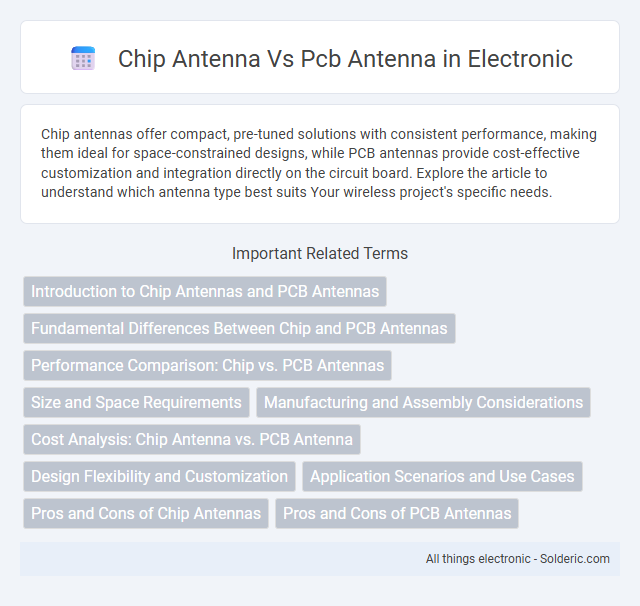Chip antennas offer compact, pre-tuned solutions with consistent performance, making them ideal for space-constrained designs, while PCB antennas provide cost-effective customization and integration directly on the circuit board. Explore the article to understand which antenna type best suits Your wireless project's specific needs.
Comparison Table
| Feature | Chip Antenna | PCB Antenna |
|---|---|---|
| Size | Compact, small form factor | Varies, typically larger due to board space |
| Cost | Higher component cost | Lower cost, integrated into PCB |
| Performance | Consistent, factory-tuned | Depends on PCB design and layout |
| Design Complexity | Simple integration, plug-and-play | Requires careful PCB layout and tuning |
| Flexibility | Limited tuning options | Highly customizable during design |
| Application | Best for compact devices with space constraints | Ideal for cost-sensitive applications with design resources |
| Reliability | Stable performance over time | Potential variability due to PCB material and design |
Introduction to Chip Antennas and PCB Antennas
Chip antennas are compact, surface-mount devices designed to provide efficient signal transmission and reception in limited spaces, commonly used in IoT and mobile devices. PCB antennas are integrated directly into the printed circuit board, offering cost-effective and customizable solutions with design flexibility for various frequency bands. Both types leverage different fabrication methods, where chip antennas use ceramic or polymer substrates, while PCB antennas rely on copper traces etched on the board layer.
Fundamental Differences Between Chip and PCB Antennas
Chip antennas are compact, pre-manufactured components offering consistent performance and simple integration in tight spaces, while PCB antennas are custom-designed patterns etched directly onto the circuit board, providing flexibility in shape and size. Your choice impacts device size, cost, and wireless efficiency due to differences in radiation patterns, frequency range, and ease of tuning. Chip antennas typically require matching circuits for optimal function, whereas PCB antennas allow for more precise impedance control during design.
Performance Comparison: Chip vs. PCB Antennas
Chip antennas offer compact size and ease of integration but typically provide lower gain and reduced range compared to PCB antennas, which are larger and can be optimized for specific frequencies, resulting in better performance. PCB antennas allow for customization in size and shape, enabling improved radiation patterns and higher efficiency, making them ideal for applications requiring long-range communication. Choosing between these depends on your device's space constraints and required signal strength, with PCB antennas generally outperforming chip antennas in terms of overall wireless performance.
Size and Space Requirements
Chip antennas offer a compact form factor, typically ranging from 3mm to 10mm, making them ideal for devices with strict space constraints. PCB antennas integrate directly onto the circuit board, eliminating separate components but requiring a larger antenna area, often several square centimeters, to achieve optimal performance. Designers prioritize chip antennas when minimizing device size is critical, while PCB antennas are favored for their cost-effectiveness and integration simplicity in larger devices.
Manufacturing and Assembly Considerations
Chip antennas offer straightforward manufacturing and assembly due to their compact size and standardized form factor, enabling automated pick-and-place processes that reduce production time and labor costs. PCB antennas, integrated directly into the circuit board, require careful design and precise etching, which can increase complexity and demand stringent quality control during fabrication. Material selection and layout constraints significantly impact PCB antenna performance, making prototyping and tuning more critical compared to the plug-and-play nature of chip antennas.
Cost Analysis: Chip Antenna vs. PCB Antenna
Chip antennas generally have higher upfront costs due to manufacturing complexities and specialized materials, while PCB antennas offer lower production expenses by integrating directly with the circuit board. Your choice impacts overall budget efficiency, as PCB antennas reduce assembly labor and component counts but may require more design iterations to achieve desired performance. Considering volume and application-specific requirements is crucial for a cost-effective antenna solution.
Design Flexibility and Customization
PCB antennas offer higher design flexibility and customization since their layout can be tailored directly on the circuit board to optimize performance for specific frequency bands and environments. Chip antennas, while compact and easy to integrate, have fixed designs with limited tunability, making them less adaptable to varying device requirements or unique form factors. Selecting between the two relies heavily on balancing the need for precise antenna tuning with constraints in space and manufacturing complexity.
Application Scenarios and Use Cases
Chip antennas are ideal for compact devices requiring efficient space utilization, such as IoT sensors, wearables, and small wireless modules, where PCB area is limited. PCB antennas suit applications needing customizable antenna patterns and higher performance, like routers, laptops, and industrial equipment with ample PCB space. Choosing the right antenna depends on your device size constraints, performance requirements, and specific use cases in wireless communication.
Pros and Cons of Chip Antennas
Chip antennas offer compact size and ease of integration, making them ideal for space-constrained applications in IoT and wearable devices. They provide consistent performance with minimal tuning, but their limited range and lower efficiency compared to PCB antennas can affect signal strength and coverage. Cost-effective mass production is another benefit, although sensitivity to PCB layout and environmental factors may require careful design considerations.
Pros and Cons of PCB Antennas
PCB antennas offer cost-effective integration and compact design, making them ideal for space-constrained devices. They provide consistent performance with minimal variation between production batches, enhancing reliability in wireless communication. However, PCB antennas can suffer from limited range and sensitivity compared to external antennas, and their performance is highly dependent on the PCB layout and surrounding components.
chip antenna vs pcb antenna Infographic

 solderic.com
solderic.com